Please support Game Informer. Print magazine subscriptions are less than $2 per issue
David Jaffe And Scott Campbell Talk Twisted Metal
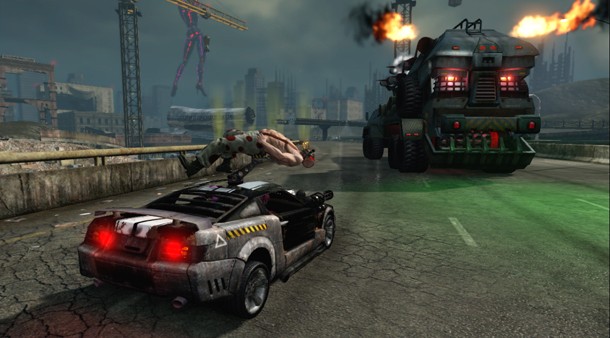
In our current issue, we feature a two-page interview with Eat Sleep Play's David Jaffe and Scott Campbell. They had more to say than we could fit in our pages, so here's the full, unabridged interview.
From the beginning, Twisted Metal’s core gameplay always seemed like a great fit for online play. We got our first taste of it with Twisted Metal Black: Online. Were you happy with how that turned out, or did you always feel like a game built from the ground up for multiplayer would be the way to go?
Scott Campbell: A lot of effort went in just because we were breaking new trail with Sony, getting the whole online thing up and running. It was pretty painful, the process of getting a full-blown online game going and I think once it was all said and done it was really exciting to be able to play multiplayer with other players in an online setting. I think it really just scratched the surface of what it could be and hopefully could evolve to and that’s kind of what we’re trying to do with this latest version.
David Jaffe: On one hand, yeah, I think you can look at Twisted Metal and say “Well of course it always should have been online,” but at the same time I don’t necessarily think that it should have always been online with 16 players, 32 players, you know...256 players. We always said the bread and butter was the multiplayer, which up until online was split screen - 2-player, maybe 4-player split screen. So the idea of throwing a boatload of other people in seemed like the equivalent of having a Street Fighter II or Mortal Kombat but instead of one-on-one, you’ve got 15 other guys that are all trying to beat everybody up. While I think Black Online was a really good step of breaking new trail and getting the technology and understanding that world a little bit better, I do think there was a tendency to just kind of go “Oh, well let’s just throw all the cars into the blender and go ‘that’s the game!’.” When you look at the beginnings of Twisted Metal, where we started saying it was gonna be a fighting game with cars, the idea of doing a fighting game with 15 other people, it can very quickly devolve into sheer chaos. How to maintain tactics and strategy and depth amid all of the noise has been a huge challenge.
Scott Campbell: The interesting thing is that everyone thinks that’s the ultimate version of Twisted, “the more players the better,” you know. Then you just get in this gridlock that just turns into noise. But most people when you first talk to them, they’re like “Oh yeah, Twisted Metal online version with 256 cars battling it out,” you know...conceptually it sounds cool. As soon as someone gets into these large pockets with 10+ cars battling, it just shows up as noise and you’re just trying to escape and you’re just watching your health bar drop to nothing. It really isn’t a fun way of playing a game.
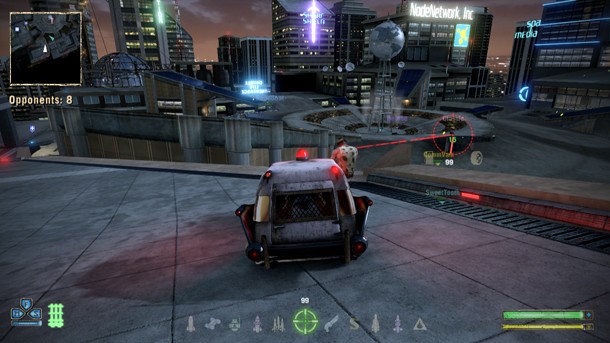
In terms of online player count, what do you think the sweet spot is in a title like this? Was it ever tempting to say “screw it, we’re doing 256 players online,” or did you always intend on keeping it somewhat limited?
David Jaffe: For me, there are two ways to make a Twisted Metal game online. One is to be total purist about it and say we’re designing this game from the ground up to be like Mortal Kombat online...one on one. I still think if we’re fortunate enough and the fans really enjoy what we’ve done with this game and we get to do downloadable content or we get to do a sequel I would love to sort of take a corner of that design and make something similar to the last Call of Duty’s Spec Ops mode. We’d say “we’re just gonna make eight levels and a number of weapons and modes that are just one on one” because I do think that really represents a sweet spot. But I think as we’ve also gotten into development and design on this game, certainly there is a case being made that you can make a really fun Twisted Metal game with more than one-on-one. I don’t think 256, I don’t. I don’t think 256 with humans...as impressive as a game like Resistance 2 or MAG is...I think they do a lot of work to curb the chaos, but I still think you really want to be able to wrap your brain around what you’re doing. To me, with Twisted Metal I’d say the sweet spot is anywhere from 5-on-5 to 8-on-8 depending on the game mode that you’re playing.
Scott Campbell: I think when David and I are kind of talking about online and multiplayer, it needs to feel like it used to. Some of those classic TM battles, and when we really analyze that, they didn’t really involve a lot of players. The more intimate battles became more memorable and required a lot more thought and skill.
David Jaffe: It’s funny because especially with new generations of players coming up, I absolutely love the Last Man Standing mode of this game. I know we have guys on the team that are into the hardcore shooting games that are like “Oh, we ****ing hate that.” I’m like “Why do you hate that?”. They say “Oh I don’t want to die and sit in a lobby.” But dude, that makes your life valuable, that means health matters, that means playing defensively matters. I’m glad we can support those modes, because I love modes like in SOCOM or Rainbow Six or now in Twisted Metal where you have a couple of lives or one life and when you’re dead you’re dead. Yeah, you might have to wait in a lobby for five or six minutes to wait for the next game, but when the next game comes you’re going in with this sense of tension and caring about your survival that I think just totally ratchets up the immersiveness of the experience.
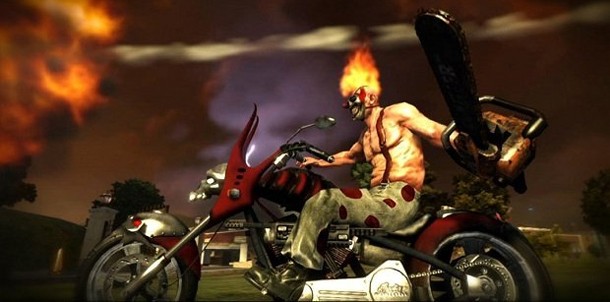
When did you first get the urge to revisit the series with a full-scale console release?
David Jaffe: It evolved. I think it evolved in the best way something could evolve. We started Eat Sleep Play and said “Let’s make small games. Let’s be a premier PSN developer.” We originally were gonna make Twisted Metal like a $9.99 or 12.99 download game and that was it. I think what happened was, as development started to come online, there was a sense that the foundation was solid and fun, and it was like “Hey, I remember Twisted Metal! This could be really, really cool.” There was sort of a continual adding to the scope and ultimately the budget and the schedule because Sony and Eat Sleep Play were like “You know, I think we should set our sights higher.” It actually began as a much smaller experience that we said “Let’s make this for the hardcore Twisted fans that we know are still out there, let’s try to bring some new fans in there as well.” As we started development, there was a sense of “hey, we could entertain a lot more people with this, but it means we’re gonna have to have more levels, more cars, more modes.” Every four or five months we’d have meetings with Sony and be like “We really need a single player now, and we really need some more multiplayer modes.” By the end of it, it kind of evolved into what it is now. I think it evolved because what we saw so early seemed to have so much potential.
Scott Campbell: We set the studio up to hit that medium-sized downloadable and a lot of the team was really passionate about doing the one player version. You start looking at what it’s gonna take to do it with this small team, and we had to make the decision and add more schedule but I think overall the extra time is gonna make the multiplayer even better and some of the new things we’re doing to the one-player are gonna appeal to a lot more people.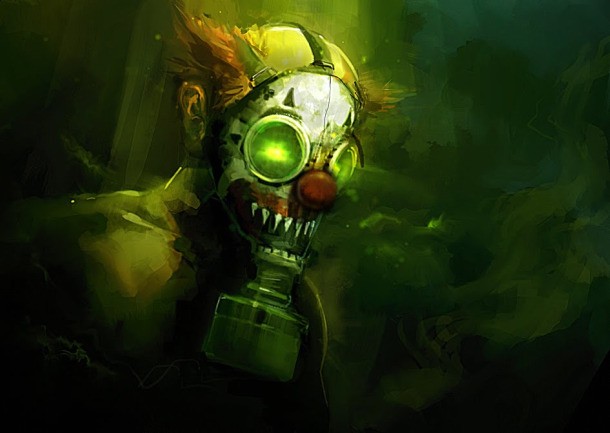
We’ve seen some concept art of two aborted early versions of the game (a modern, realistic look and one set in the apocalypse). How far into development did these get? Were there ever playable versions of these or were they strictly confined to the concept art stage?
Scott Campbell: The city level that you saw at E3 in the Nuke version of the presentation was at one time all sleek and stylized to that visual theme. That one completely changed. We actually had prototype running in that. On the apocalypse front, we never really had full-blown apocalypse, but there are some elements that you’ll find in the city level. Not full-blown apocalyptic, but there is some definite deterioration that you see in the city that sort of could be construed as apocalyptic.
David Jaffe: It took a while for our technology to catch up to our ambitions and I think what happened was we were showing the game off and there was this sense of “this doesn’t have any personality.” But until you have all your really cool effects in that can kind of take an environment that’s kind of normal and really give it a hyper-heightened sense of sexy, cool reality, it’s just gonna look like a bland environment. I think all of us were feeling kind of nervous because we weren’t seeing that. We were like “****, people are saying the game is bland.” We can never have a bland Twisted Metal game. I think that kind of helps evolve the more nightclubby vibe, which in retrospect, we put it out on the net, we took it to Comic Con...nobody liked it. The team didn’t like it. I liked it, but that doesn’t mean it would have been right. It could have gone down in flames, so I think it was the right decision. It was good we didn’t continue with that, but the real reason we didn’t was because we were like “****, we need to inject some classic Twisted Metal personality into this ASAP” so Sony sort of stays on board with us here.
Scott Campbell: The other thing that steered us in that direction was trying to make it more internationally appealing so it was more accepted in some of the other territories like the U.K. and maybe even Japan that respond a little more to that high-tech, very super-polished look. Part of Twisted’s personality has been that it didn’t always have super-stellar graphics, but over the years that became kind of its voice. It was a little on the grungy side, there was an element of randomness to the look. I think what we’ve got now is definitely a better fit.
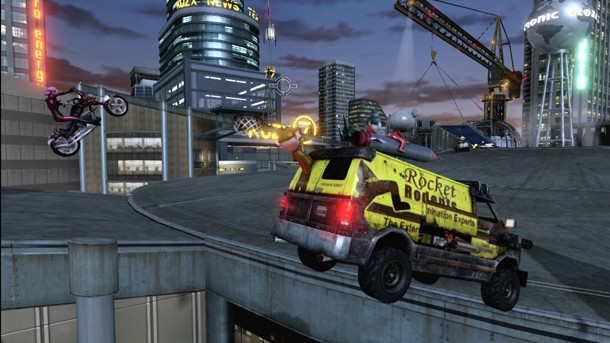
Twisted Metal 2 had somewhat dark, sometimes violent endings with a cartoonish art style. Twisted Metal Black was more realistic, featuring much darker themes and far more gore. Where will the new Twisted Metal lie on this spectrum?
David Jaffe: Black had kind of decent CG for its time, but the new ones aren’t CG, and they aren’t 2D Flash cartoons. They’re live action, sort of a cross between full-motion video and comic books come to life. The visual style is unique. In terms of comparing it to the other two games’ tone, I would say these aren’t as dark as Black in the sense that they’re really pushing boundaries of taste. We don’t have a preacher crucifying himself to a wall or drowning a baby, we’re not going to that level. But the actual stories themselves and the characters themselves are actually more sad and darker and twisted and the stories are a little more psychological Twilight Zone than they were in Black. The endings aren’t as goofy as they were in Twisted 2. It’s kind of its own thing, but it takes elements of both of them. You still have Calypso there, you still have him granting wishes, and you still have contestants that really need to be careful what they ask for because they end up getting it. I think it’s got a bit more psychological creepiness to it than the full-blown gorefest that Black was.
So nothing like the campy deleted endings from the original game?
David Jaffe: Ideally, they won’t be campy at all. We finished production, and we were in the mindset of “we cannot be cheesy.” Even though we had that mindset, lo and behold we had people saying “these are kind of cheesy in parts.” So we spent the last couple of months going let’s get rid of this, let’s get rid of that shot. We don’t want these to come off as campy at all, that’s not the intent. There are some endings that are kind of sick and twisted and funny and others are a little more sad and disturbing and darker. They’re not all “ha ha” one-joke gimmicks, although there are a few of those. They kind of run the spectrum.
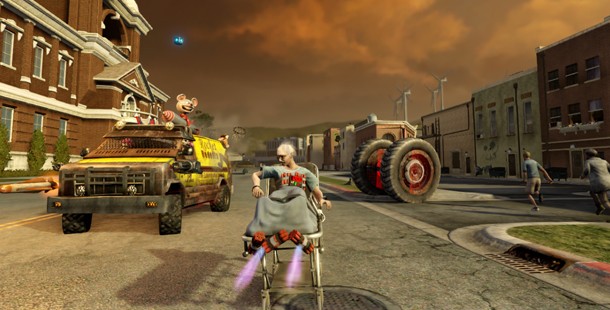
What about in-game comedy, like shooting the kid into the swimming pool in New York or running over mimes in Paris? Will it stay more serious in-game as well?
David Jaffe: We do let you launch a gurney out the back of an ambulance and you can steer it with a patient on it screaming with TNT strapped to him. That’s in there. We’ve got a number of things embedded into the core experience that we feel represent that Twisted style. You have a car with a magnet on the front that can pull a car in and you can charge it up and launch an enemy at other enemy, and you hear them screaming as they fly through the air. That’s represented, and I think destroying environments that people hold near and dear...the fact that you can drive cars and monster trucks into a grocery store or a church or a high school I think represents that. So yeah, that’s always been in our mindset.
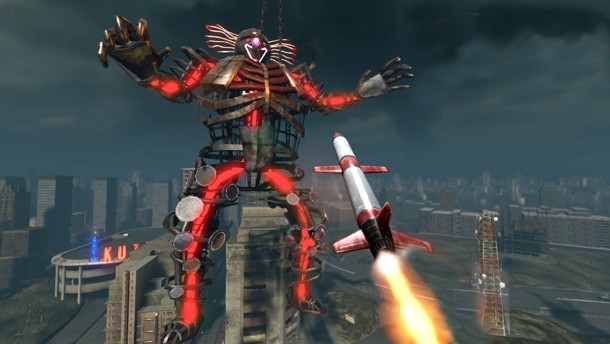
You showed off Nuke mode at E3, which was far more elaborate than
the standard deathmatches seen in the series’ past. Will there be any
other modes that feature this level of complexity?
Scott
Campbell: I think that mode will probably be our most strategic
team-based game, not to say that the other modes won’t evolve. If you’re
playing as a team you can develop some pretty good strategies but I
think Nuke is definitely the most elaborate in that department.
David Jaffe: I agree with what you’re saying about the other modes
because all the weapons and vehicles are designed to promote deeper team
play if you want it. This goes back to what we were talking about with
the sweet spot of players. We have a helicopter in the game that we
showed at E3, and if you just want to play deathmatch and be the
aggressor you can absolutely do that and go into turret mode and go to
town. If you’re more interested in playing as a team and you’re playing
team Last Man Standing and you’re sharing lives and you see your buddy
about to die, you can drop a magnet and airlift him out of harm’s way.
Even in more simple, straightforward modes like team deathmatch or team
Last Man Standing, the weapons themselves for certain players will have
that complexity and tactics available. In terms of the core mode, I’d
agree with Scott in saying Nuke is the most complicated.
You’ve said that you want team-based gameplay to be a huge component of this game. Do you plan on featuring any support for clans, online stat-tracking, anything of that nature?
David Jaffe: In terms of ranking and stats, yeah...all that will be in there. Ranking up will be in there. A party system will be in there. The clan system I’m not sure yet if we’re gonna ship with or not. I think that’s still on the table. There’s definitely a persistence to your actions and your characters and a rank-up and leaderboards and all of that is certainly a big part of that. Our website as well will also aid substantially in building and fostering a very strong community around the title.
Most of the PSone titles had a “world tour” theme, and Black stuck to unspecific locations (neighborhood, skyscrapers, etc.). What is your approach to stage location in the new title?
Scott Campbell: You’ll get all flavors of levels, but a lot of them fit into the category of Anytown, U.S.A..
David Jaffe: It’s non-specific, but the battles are in places that you can relate to. They’re not exotic locations, they’re all places that you’ve probably driven your car before is kind of the idea. If you haven’t driven your car through it, you’ve probably looked at it and said “man, that would be fun to drive a car there.” Places in your own backyard for the most part is the mantra. In terms of how it’s different from Black...the mistake we made with that was being so beholden to that color palette that was a lot of greys and browns and black in order to keep the tone consistent. I think we did a great job of that, but in exchange there was a lack of visual variety. I think we’ve managed to keep our tone consistent this time around but at the same time every level should really color palette-wise give you sort of a sense of difference.
What about levels that expand as the round goes on?
David Jaffe: We had the iceberg level in TM2 that started big and shrank, then we had the boat level in Black that started small and grew. The thing that I always found interesting about that was that we got a lot of press and talk about it but when you actually play it, it never really played into the experience at the level that we wanted it to. We thought it would be a game-changer when you played, and it’s more like “Oh yeah, I guess the level is getting bigger.” It’s almost like an afterthought. We don’t have any that do that anymore. What we do have is a level that we haven’t shown yet that evolves and changes as you play. We’re still trying to sort of thread that needle because we feel that changing environments during gameplay are really cool, but we’re trying to get one that feels more substantial to the actual moment-to-moment play experience. I think we may have nailed it with this one but we’re not done yet, so it’s hard to say.
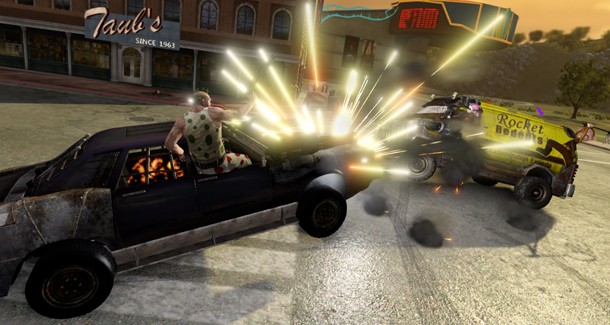
At this stage in development, do you have a personal favorite weapon or environmental attack?
Scott Campbell: For me, I kind of switch. I’ll get really used to playing a level, get really excited, but when the new one comes it becomes my new favorite. They all kind of have their own little hooks that appeal to me. I still really like the city level, it’s a large level with lots of cool circuitry. It’s got a cool vertical element that really complements the gameplay. On the weapons front, some of the new ones that we’ve put in there and just modifications to the ones that we’ve already got, I can’t really say there’s a favorite. Sniper’s pretty fun.
David Jaffe: I agree on the city. I don’t know if it’s my favorite, but it’s one of my favorites. If you remember the very first Twisted Metal, the first level that was ever made was an arena that was about the size of a grocery store. Now if you look at the city it’s not even big so much, but it feels like we’re delivering on the fantasy that we had back in ‘94 when we were developing the first Twisted Metal - living in a full-scale, real car combat experience on the freeway. Now if you look at City, there are overpasses and underpasses and underground parking garages and spiral ramps that lead up to rooftops and the slum area and a junkyard and a freeway that connects it all and it’s like ****, this is the fantasy! I think that’s one of the reasons City stands out. As a weapon, both my favorite in conception and gameplay is the weapon you have on the motorcycle which is the chainsaw. I love it for two reasons - I love that you can pop a wheelie and drag it along the ground and it kind of sparks the metal on the chainsaw and sets it on fire and does 2x damage. I love that you have that risk/reward preparation...can you get it flaming and then take the shot? Even if you’re not flaming it, taking the shot is great because the animation has this windup where he has to draw back and throw it. At first it’s really frustrating because it’s like what the ****, it’s impossible to hit with this! Then you start learning that timing, and when you actually connect with it, it feels ****ing great when you actually connect with that chainsaw.
It seems that all of these stages are standalone stages like in the classic games. When you were working on the aborted Twisted Metal: Harbor City, there was talk of making the areas all interconnected into one gigantic world. Did you ever consider implementing this concept in the new installment?
Scott Campbell: That was a very ambitious undertaking and Harbor City was gonna be more of an objective-based version of Twisted with lots of deathmatch in-between. There are some really constraining things when you go down that path that we experienced that kind of prevented you from doing the old variety of levels that we’ve done in the past. You really start missing those. It’s great to have a big, huge environment, but on the same token you really start missing those really intense, smaller arena-type levels. For this one, we’ve got more classic Twisted like what you saw in TM2 or Black. Levels of all different varieties and sizes and hooks and elements.
David Jaffe: The other thing to remember is that we started and remain committed to making this game have the best single-player we’ve ever done and the bosses are all amazing, but it’s not Alan Wake. If you buy Twisted Metal because you want some great adventure single-player thing, that’s not what this is. For us, I would say so much of our passion and resources have gone into how we make this the best multiplayer game that’s out there. The single-player is gonna be great and fun, it’s got some really cool stuff, but when you’re talking about connecting levels like that, for the most part you don’t unless you’re doing an MMO, or a single player or campaign experience. For us it was about how that might be cool down the road, but how do we make the most amazing multiplayer game that’s out there?
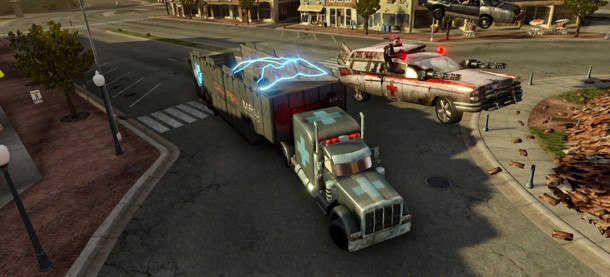
Health bars seem to be a dying breed in modern games. Have you ever considered adding Twisted Metal to the list of games that utilize recharging health?
Scott Campbell: One of the core mechanics that has made the franchise
successful is the pickup game. When you’re running low on health, that
becomes the mother of all pickups. Part of what many players will do,
myself included, is explore the level and create kind of these
high-speed battle circuits that incorporate where the health pickups are
and just the satisfaction of getting in that circuitry and going into
battle and going out to repair your car. I don’t know, I still find a
lot of fulfillment when I’m a couple pixels of red away from dying and
getting that last health pickup. I think it’s just such a core mechanic
to the game. The other cool thing about the health semi is that you can
destroy it just like any other vehicle.
David Jaffe: And it can ram you, too. You come around a corner looking
for health and you’re not paying attention, it can ram you and take half
your health. I love health packs, I love health bars...for this game. I’m not saying I don’t appreciate the value that regen health brings to an FPS. Because you don’t have the fidelity of motion of a human character, the moment-to-moment interaction in a Twisted Metal game or any other kind of vehicle game is relatively simple. Your death comes less from crouching and strafing and looking up and hiding in a corner and waiting for someone to come around the corner to shoot you. It comes more from the weapons, the mechanics of the weapons, and using the environment. We have health semis in the new game that you can chase down like Knight Rider or Spy Hunter and you have this jostling battle with a guy you’re trying to kill who’s about to leap in the back of a semi truck to take 100% health and you’re trying to use freeze missiles and ram him to stop him before he gets in there. Without those semi trucks, without health packs, without “****, you’re about to kill me in Last Man Standing, I’ve gotta race across the level to get health”...without that, we really lose those opportunities to create that back-and-forth, cat-and-mouse tug of war that I feel represents so much of what the classic Twisted Metal games were in split-screen. We’ve talked about regen health every now and then, but for me it comes at too much of a cost.
We explored for a while “hey, maybe we should do more of a traditional loadout.” Pick a shotgun and a missile, that’s your loadout. It is a much simpler experience, you can put control in anybody’s hand. Unlike Twisted Metal, which has always had a little bit of a learning curve since you’re dealing with a lot more things you can do, it comes at too great of a cost to the core formula. Suddenly you’re only doing the same thing over and over versus “hey, now I’ve got a sniper rifle. Now I’ve got a swarmer missile. Now I have a remote control car.” Every time you get that, it allows you to change tactics and change the way you play. There are some things that I think people would call antiquated that I still look at with the Twisted Metal series and say this is such a core aspect of its DNA that if we lost it, we’d really lose a lot of the heart and soul of what makes the game great.










